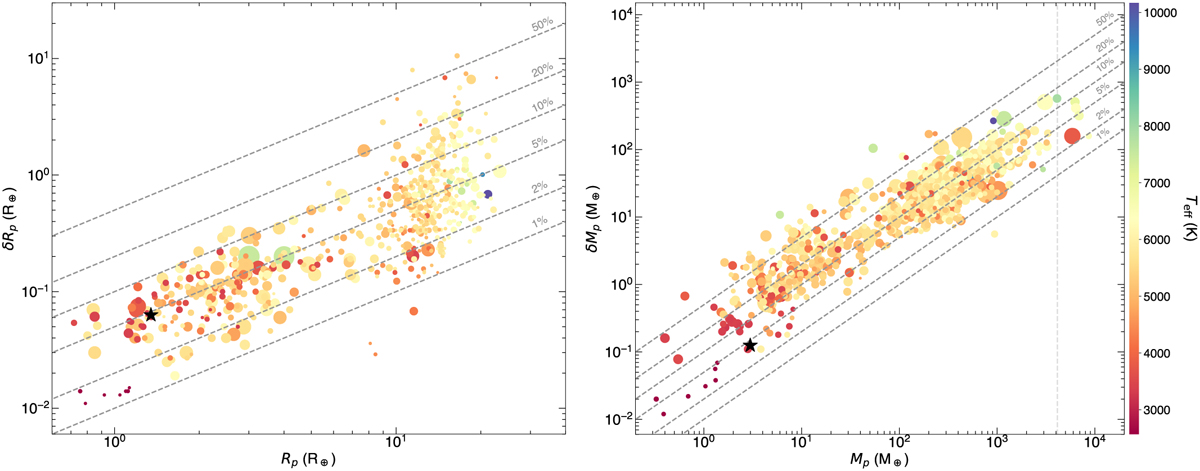Fig. B.1

Download original image
Uncertainty in radius versus radius (left) and uncertainty in mass versus mass (right) of all transiting exoplanets with mass determination (from RV or transit time variations). The symbol colour denotes the stellar host effective temperature, while the symbol size is proportional to mass and radius, respectively. Diagonal dashed lines indicate lines of constant relative uncertainty (1, 2, 5, 10, 20, 50%). Gl 486 b is marked with a black star in both panels. Only in the right panel, the grey vertical dotted line marks the deuterium burning mass limit. The planets with δRp/Rp ratios less than 1 % (left panel) are Kepler-16 b ![]() , a Saturn-size circumbinary planet around a eclipsing binary with both precise and accurate stellar mass and radius determination (Doyle et al. 2011), HATS-72b (Rp = 8.097 ± 0.036 R⊕), whose stellar host is a K dwarf with a questionable tabulated relative radius uncertainty of merely 0.29% (Hartman et al. 2020), and Wendelstein-1 b (Rp = 11.561 ± 0.068 R⊕), for which the uncertainty in the stellar radius was not correctly propagated (Obermeier et al. 2020). The planet with δMp/Mp ratio less than 1% (right panel) is TIC 172900988 b (Mp = 942.0 ± 5.6 M⊕ for one of the six possible model solutions), a Jupiter-size circumbinary planet around another eclipsing binary (Kostov et al. 2021).
, a Saturn-size circumbinary planet around a eclipsing binary with both precise and accurate stellar mass and radius determination (Doyle et al. 2011), HATS-72b (Rp = 8.097 ± 0.036 R⊕), whose stellar host is a K dwarf with a questionable tabulated relative radius uncertainty of merely 0.29% (Hartman et al. 2020), and Wendelstein-1 b (Rp = 11.561 ± 0.068 R⊕), for which the uncertainty in the stellar radius was not correctly propagated (Obermeier et al. 2020). The planet with δMp/Mp ratio less than 1% (right panel) is TIC 172900988 b (Mp = 942.0 ± 5.6 M⊕ for one of the six possible model solutions), a Jupiter-size circumbinary planet around another eclipsing binary (Kostov et al. 2021).
Current usage metrics show cumulative count of Article Views (full-text article views including HTML views, PDF and ePub downloads, according to the available data) and Abstracts Views on Vision4Press platform.
Data correspond to usage on the plateform after 2015. The current usage metrics is available 48-96 hours after online publication and is updated daily on week days.
Initial download of the metrics may take a while.


